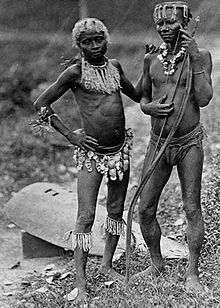네그리토

네그리토(Negrito)는 동남아시아에서 뉴기니섬에 걸쳐 사는 소수 민족을 말하며, 이 지역에 말레이계 민족이 퍼지기 전에 있었던 원주민이라고 생각된다. 안다만 제도의 원주민족들(대안다만족, 옹게족, 자라와족, 센티넬족), 말레이반도 내륙의 세망족, 태국 남부의 마니족, 필리핀의 아에타족, 아티족, 마만와족 등 4개 이상의 민족 등이 네그리에 포함된다. 뉴기니에 사는 비슷한 형질의 집단은 네그리토와는 별도로, "멜라네시아 피그미"로 불렸다.
기원
[편집]
인지된 물리적 유사성에 기반하여 네그리토는 한때 밀접하게 관련된 사람들의 단일 인구로 간주되었다. 그러나 현대의 유전학적 연구에 따르면 동아시아계와 파푸아계의 경계선상에 위치하여 여러 개의 분리된 집단으로 구성되어 있음을 시사하며 서로 유전적 이질성을 보인다. 그들은 대체로 오스트로네시아 민족으로 대체되거나 흡수되거나 지리적으로 고립된 지역에서 소수 집단을 형성한다.[1][2]

최근 여러 연구에 따르면 네그리토로 분류된 다양한 그룹이 동아시아인과 파푸아인 사이의 경계선에 존재한다는 사실이 밝혀졌다. 안다만 사람들은 대부분 "기저 동아시아인 계통"이며 중국 북부의 톈위안인(Tianyuan man)과 같은 고대 동아시아 표본을 포함하여 현대 동아시아인과 가장 가까운 것으로 밝혀지지만 오스트랄라시아인과는 분명히 구별된다. 동아시아계 인구와 오스트랄라시아인(파푸아인 등)은 기원전 58,000년에 분리된 것으로 추정된다.[3][4][5][6][7]
일부 연구에서는 유전적 증거가 안다만 제도, 말레이 반도 및 필리핀의 "네그리토" 그룹 간의 특정 공유 조상 개념을 반박하기 때문에 각 그룹을 별도로 고려해야 한다고 제안했다.[8]

같이 보기
[편집]각주
[편집]- ↑ Larena, Maximilian; Sanchez-Quinto, Federico; Sjödin, Per; McKenna, James; Ebeo, Carlo; Reyes, Rebecca; Casel, Ophelia; Huang, Jin-Yuan; Hagada, Kim Pullupul (2021년 3월 30일). “Multiple migrations to the Philippines during the last 50,000 years”. 《Proceedings of the National Academy of Sciences of the United States of America》 118 (13): e2026132118. doi:10.1073/pnas.2026132118. ISSN 0027-8424. PMC 8020671. PMID 33753512.
- ↑ Carlhoff, Selina; Duli, Akin; Nägele, Kathrin; Nur, Muhammad; Skov, Laurits; Sumantri, Iwan; Oktaviana, Adhi Agus; Hakim, Budianto; Burhan, Basran (2021년 8월). “Genome of a middle Holocene hunter-gatherer from Wallacea”. 《Nature》 (영어) 596 (7873): 543–547. doi:10.1038/s41586-021-03823-6. ISSN 1476-4687.
- ↑ Carlhoff, Selina; Duli, Akin; Nägele, Kathrin; Nur, Muhammad; Skov, Laurits; Sumantri, Iwan; Oktaviana, Adhi Agus; Hakim, Budianto; Burhan, Basran (2021). “Genome of a middle Holocene hunter-gatherer from Wallacea”. 《Nature》 596 (7873): 543–547. doi:10.1038/s41586-021-03823-6. ISSN 0028-0836. PMC 8387238. PMID 34433944.
- ↑ Larena, Maximilian; Sanchez-Quinto, Federico; Sjödin, Per; McKenna, James; Ebeo, Carlo; Reyes, Rebecca; Casel, Ophelia; Huang, Jin-Yuan; Hagada, Kim Pullupul (2021년 3월 30일). “Multiple migrations to the Philippines during the last 50,000 years”. 《Proceedings of the National Academy of Sciences of the United States of America》 118 (13): e2026132118. doi:10.1073/pnas.2026132118. ISSN 0027-8424. PMC 8020671. PMID 33753512.
- ↑ “Genomic insights into the origin of pre-historic populations in East Asia” (영어). 2021년 12월 22일에 확인함.
- ↑ Larena, Maximilian; McKenna, James; Sanchez-Quinto, Federico; Bernhardsson, Carolina; Ebeo, Carlo; Reyes, Rebecca; Casel, Ophelia; Huang, Jin-Yuan; Hagada, Kim Pullupul (2021년 10월 11일). “Philippine Ayta possess the highest level of Denisovan ancestry in the world”. 《Current Biology》 31 (19): 4219–4230.e10. doi:10.1016/j.cub.2021.07.022. ISSN 0960-9822. PMC 8596304. PMID 34388371.
- ↑ Genetics and material culture support repeated expansions into Paleolithic Eurasia from a population hub out of Afri, Vallini et al. 2021 (October 15, 2021) Quote: "Taken together with a lower bound of the final settlement of Sahul at 37 kya (the date of the deepest population splits estimated by 1) it is reasonable to describe Oceanians as an almost even mixture between East Asians and a basal lineage, closer to Africans, which occurred sometimes between 45 and 37kya."
- ↑ Catherine Hill; Pedro Soares; Maru Mormina; Vincent Macaulay; William Meehan; James Blackburn; Douglas Clarke; Joseph Maripa Raja; Patimah Ismail; David Bulbeck; Stephen Oppenheimer; Martin Richards (2006), "Phylogeography and Ethnogenesis of Aboriginal Southeast Asians" (PDF), Molecular Biology and Evolution, 23 (12): 2480–91, doi:10.1093/molbev/msl124, PMID 16982817, archived from the original (PDF) on 9 April 2008
